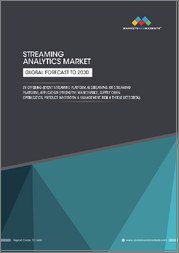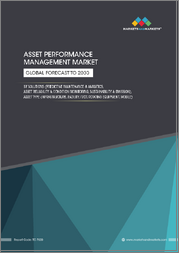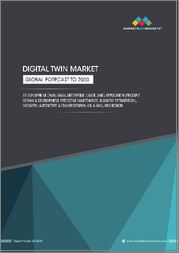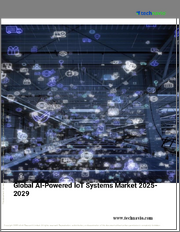
|
시장보고서
상품코드
1722421
예지보전 시장 보고서 : 컴포넌트, 기법, 전개 유형, 조직 규모, 업계별, 지역별(2025-2033년)Predictive Maintenance Market Report by Component, Technique, Deployment Type, Organization Size, Industry Vertical, and Region 2025-2033 |
||||||
세계 예지보전 시장 규모는 2024년 127억 달러에 달했습니다. 향후 IMARC Group은 2033년에는 806억 달러에 도달하고, 2025-2033년 22.8%의 연평균 성장률(CAGR)을 보일 것으로 예측했습니다. 기계 간(M2M) 통신의 사용 확대와 고급 검사를 수행하기 위한 원격 모니터링과의 통합이 시장을 주도하고 있습니다.
예지보전은 운전 중인 장비의 성능을 모니터링하기 위한 상태 모니터링 도구와 시스템에 의존하는 기술을 말합니다. 사물인터넷(IoT), 인공지능(AI), 통합 시스템으로 구성되어 다양한 자산과 시스템을 연결하고 중요한 데이터를 공유 및 분석합니다. 또한 예지보전 센서, 산업용 제어장치, 기업자산관리(EAM) 및 기업자원계획(ERP) 소프트웨어 등의 비즈니스 시스템으로 구성됩니다. 상태 모니터링 장치를 활용하여 자산의 성능을 검사 및 평가함으로써 기능합니다. 온도, 진동, 전도도 등 다양한 데이터를 기록하여 엔지니어가 장비나 자산의 고장을 예측하고 사전에 교체나 수리를 할 수 있도록 합니다. 유지보수 비용 절감, 장비 보관 기간 연장, 생산성 향상에 기여합니다. 또한, 예지보전은 안전 규정 준수 및 선제적 시정 조치를 제공하기 때문에 전 세계적으로 수요가 증가하고 있습니다.
예지보전 시장 동향 :
현재 예지보전 수요가 증가하고 있는 것은 다양한 산업 자산의 운영 자동화가 진행되고 있기 때문이며, 이는 시장에 긍정적인 영향을 미치는 주요 요인 중 하나입니다. 또한 M2M(Machine-to-Machine) 통신과 클라우드 기술의 활용이 진행되면서 산업 자산과 비즈니스 자산에서 얻을 수 있는 다양한 정보를 조사할 수 있게 되어 시장 전망은 양호한 임베디드니다. 또한, 기술자가 적절한 절차를 통해 수리를 계획하고 준비하기 위해 예지보전을 채택하는 경우가 증가하고 있습니다. 이는 생산 주기의 중단과 계획되지 않은 다운타임을 방지하기 위해 예지보전을 채택하는 사례가 증가하면서 시장 성장을 가속하고 있습니다. 이와는 별도로, 가시적인 투자수익률(ROI)을 창출하기 위해 기업들의 예지보전 활용이 증가하고 있습니다. 이와 더불어, 노후화된 다양한 산업기계의 수명을 연장하기 위한 투자가 증가하고 있는 것도 시장 성장에 기여하고 있습니다. 또한, 예지보전과 원격 모니터링의 통합이 진행되어 고도의 검사 및 부품/설비의 고장 예측이 가능해졌습니다는 점도 시장 성장을 뒷받침하고 있습니다. 또한, 의료 인프라의 신뢰성을 향상시키기 위해 헬스케어 분야에서 예지보전 채택이 증가하고 있는 것도 시장 성장을 가속하고 있습니다.
본 보고서에서 다룬 주요 질문
- 2024년 세계 예지보전 시장 규모는?
- 2025-2033년 예지보전 세계 시장 성장률 전망은?
- 예지보전 세계 시장을 이끄는 주요 요인은?
- 코로나19가 예지보전 세계 시장에 미치는 영향은?
- 예지보전 세계 시장의 구성요소별 분류는?
- 예지보전 세계 시장에서의 기술별 구분은?
- 전개 유형에 따른 예지보전 세계 시장 분석은?
- 조직 규모에 따른 예지보전 세계 시장 현황은?
- 업종별 예지보전 세계 시장 현황은?
- 예지보전 세계 시장의 주요 지역은?
- 예지보전 세계 시장의 주요 기업은?
목차
제1장 서문
제2장 조사 범위와 조사 방법
- 조사 목적
- 이해관계자
- 데이터 소스
- 1차 정보
- 2차 정보
- 시장 추정
- 보텀업 접근
- 톱다운 접근
- 조사 방법
제3장 주요 요약
제4장 서론
- 개요
- 주요 업계 동향
제5장 세계의 예지보전 시장
- 시장 개요
- 시장 실적
- COVID-19의 영향
- 시장 예측
제6장 시장 분석 : 컴포넌트별
- 솔루션
- 서비스
제7장 시장 분석 : 기법별
- 진동 모니터링
- 전기 시험
- 오일 분석
- 초음파 가스 누출 검출기
- 쇼크 펄스
- 적외선
- 기타
제8장 시장 분석 : 전개 유형별
- 클라우드 기반
- On-Premise
제9장 시장 분석 : 조직 규모별
- 중소기업
- 대기업
제10장 시장 분석 : 업계별
- 제조
- 에너지 및 유틸리티
- 항공우주 및 방위
- 운송 및 물류
- 정부
- 헬스케어
- 기타
제11장 시장 분석 : 지역별
- 북미
- 미국
- 캐나다
- 아시아태평양
- 중국
- 일본
- 인도
- 한국
- 호주
- 인도네시아
- 기타
- 유럽
- 독일
- 프랑스
- 영국
- 이탈리아
- 스페인
- 러시아
- 기타
- 라틴아메리카
- 브라질
- 멕시코
- 기타
- 중동 및 아프리카
- 시장 내역 : 국가별
제12장 SWOT 분석
- 개요
- 강점
- 약점
- 기회
- 위협
제13장 밸류체인 분석
제14장 Porter의 Five Forces 분석
- 개요
- 바이어의 교섭력
- 공급 기업의 교섭력
- 경쟁 정도
- 신규 진출업체의 위협
- 대체품의 위협
제15장 가격 분석
제16장 경쟁 구도
- 시장 구조
- 주요 기업
- 주요 기업 개요
- Asystom
- C3.ai Inc.
- General Electric Company
- Google LLC(Alphabet Inc.)
- Hitachi Ltd.
- International Business Machines Corporation
- Microsoft Corporation
- PTC Inc.
- SAP SE
- Software AG
- Tibco Software Inc.
- Uptake Technologies Inc.
The global predictive maintenance market size reached USD 12.7 Billion in 2024. Looking forward, IMARC Group expects the market to reach USD 80.6 Billion by 2033, exhibiting a growth rate (CAGR) of 22.8% during 2025-2033. The growing use of machine-to-machine (M2M) communication, coupled with the rising integration with remote monitoring to conduct advanced inspections, is primarily propelling the market.
Predictive maintenance refers to the technique that relies on condition-monitoring tools and systems to monitor the performance of equipment during operation. It comprises the internet of things (IoT), artificial intelligence (AI), and integrated systems to connect different assets and systems and share and analyze crucial data. It also consists of predictive maintenance sensors, industrial controls, and business systems, such as enterprise asset management (EAM) and enterprise resource planning (ERP) software. It functions by utilizing condition monitoring equipment to examine and evaluate the performance of assets. It records a wide range of data, such as temperature, vibrations, and conductivity, which enables an engineer to predict the failure of equipment or assets while allowing them to be replaced or repaired in advance. It helps reduce maintenance costs, increase the shelf life of equipment, and improve productivity. Furthermore, as predictive maintenance provides safety compliance and preemptive corrective actions, its demand is increasing around the world.
Predictive Maintenance Market Trends:
At present, the rising demand for predictive maintenance due to the increasing automation of operations of various industrial assets represents one of the primary factors influencing the market positively. Besides this, the growing utilization of machine-to-machine (M2M) communication and cloud technology to investigate a wide array of information derived from industrial and business assets is offering a favorable market outlook. Additionally, there is an increase in the adoption of predictive maintenance by technicians to plan and prepare for a repair by taking appropriate steps. This, along with the rising employment of predictive maintenance to prevent the disruption of production cycles and the occurrence of unplanned downtime, is propelling the growth of the market. Apart from this, there is a rise in the utilization of predictive maintenance by businesses to generate a tangible return on investment (ROI). This, coupled with the increasing investment in extending the lifespan of various aging industrial machinery, is contributing to the growth of the market. In addition, the rising integration of predictive maintenance with remote monitoring to conduct advanced inspections and predict component and equipment failures is supporting the market growth. Moreover, the increasing employment of predictive maintenance in the healthcare sector to improve the reliability of healthcare infrastructure is bolstering the market growth.
Key Market Segmentation:
Component Insights:
- Solution
- Service
Technique Insights:
- Vibration Monitoring
- Electrical Testing
- Oil Analysis
- Ultrasonic Leak Detectors
- Shock Pulse
- Infrared
- Others
Deployment Type Insights:
- Cloud-based
- On-premises
Organization Size Insights:
- Small and Medium-sized Enterprises
- Large Enterprises
Industry Vertical Insights:
- Manufacturing
- Energy and Utilities
- Aerospace and Defense
- Transportation and Logistics
- Government
- Healthcare
- Others
Regional Insights:
- North America
- United States
- Canada
- Asia-Pacific
- China
- Japan
- India
- South Korea
- Australia
- Indonesia
- Others
- Europe
- Germany
- France
- United Kingdom
- Italy
- Spain
- Russia
- Others
- Latin America
- Brazil
- Mexico
- Others
- Middle East and Africa
- The report has also provided a comprehensive analysis of all the major regional markets, which include North America (the United States and Canada); Asia Pacific (China, Japan, India, South Korea, Australia, Indonesia, and others); Europe (the United Kingdom, Germany, France, Italy, Spain, Russia, and others); Latin America (Brazil, Mexico, and others); and the Middle East and Africa. According to the report, North America (the United States and Canada) was the largest market for predictive maintenance. Some of the factors driving the North America predictive maintenance market included the growing demand for remote monitoring facilities, rising technological advancements in business automation processes, increasing number of solution and service vendors, etc.
Competitive Landscape:
- The report has also provided a comprehensive analysis of the competitive landscape in the global predictive maintenance market. Competitive analysis such as market structure, market share by key players, player positioning, top winning strategies, competitive dashboard, and company evaluation quadrant has been covered in the report. Also, detailed profiles of all major companies have been provided. Some of the companies covered include Asystom, C3.ai Inc., General Electric Company, Google LLC (Alphabet Inc.), Hitachi Ltd., International Business Machines Corporation, Microsoft Corporation, PTC Inc., SAP SE, Software AG, Tibco Software Inc., Uptake Technologies Inc., etc. Kindly note that this only represents a partial list of companies, and the complete list has been provided in the report.
Key Questions Answered in This Report
- 1.What was the size of the global predictive maintenance market in 2024?
- 2.What is the expected growth rate of the global predictive maintenance market during 2025-2033?
- 3.What are the key factors driving the global predictive maintenance market?
- 4.What has been the impact of COVID-19 on the global predictive maintenance market?
- 5.What is the breakup of the global predictive maintenance market based on the component?
- 6.What is the breakup of the global predictive maintenance market based on the technique?
- 7.What is the breakup of the global predictive maintenance market based on deployment type?
- 8.What is the breakup of the global predictive maintenance market based on the organization size?
- 9.What is the breakup of the global predictive maintenance market based on the industry vertical?
- 10.What are the key regions in the global predictive maintenance market?
- 11.Who are the key players/companies in the global predictive maintenance market?
Table of Contents
1 Preface
2 Scope and Methodology
- 2.1 Objectives of the Study
- 2.2 Stakeholders
- 2.3 Data Sources
- 2.3.1 Primary Sources
- 2.3.2 Secondary Sources
- 2.4 Market Estimation
- 2.4.1 Bottom-Up Approach
- 2.4.2 Top-Down Approach
- 2.5 Forecasting Methodology
3 Executive Summary
4 Introduction
- 4.1 Overview
- 4.2 Key Industry Trends
5 Global Predictive Maintenance Market
- 5.1 Market Overview
- 5.2 Market Performance
- 5.3 Impact of COVID-19
- 5.4 Market Forecast
6 Market Breakup by Component
- 6.1 Solution
- 6.1.1 Market Trends
- 6.1.2 Market Forecast
- 6.2 Service
- 6.2.1 Market Trends
- 6.2.2 Market Forecast
7 Market Breakup by Technique
- 7.1 Vibration Monitoring
- 7.1.1 Market Trends
- 7.1.2 Market Forecast
- 7.2 Electrical Testing
- 7.2.1 Market Trends
- 7.2.2 Market Forecast
- 7.3 Oil Analysis
- 7.3.1 Market Trends
- 7.3.2 Market Forecast
- 7.4 Ultrasonic Leak Detectors
- 7.4.1 Market Trends
- 7.4.2 Market Forecast
- 7.5 Shock Pulse
- 7.5.1 Market Trends
- 7.5.2 Market Forecast
- 7.6 Infrared
- 7.6.1 Market Trends
- 7.6.2 Market Forecast
- 7.7 Others
- 7.7.1 Market Trends
- 7.7.2 Market Forecast
8 Market Breakup by Deployment Type
- 8.1 Cloud-based
- 8.1.1 Market Trends
- 8.1.2 Market Forecast
- 8.2 On-premises
- 8.2.1 Market Trends
- 8.2.2 Market Forecast
9 Market Breakup by Organization Size
- 9.1 Small and Medium-sized Enterprises
- 9.1.1 Market Trends
- 9.1.2 Market Forecast
- 9.2 Large Enterprises
- 9.2.1 Market Trends
- 9.2.2 Market Forecast
10 Market Breakup by Industry Vertical
- 10.1 Manufacturing
- 10.1.1 Market Trends
- 10.1.2 Market Forecast
- 10.2 Energy and Utilities
- 10.2.1 Market Trends
- 10.2.2 Market Forecast
- 10.3 Aerospace and Defense
- 10.3.1 Market Trends
- 10.3.2 Market Forecast
- 10.4 Transportation and Logistics
- 10.4.1 Market Trends
- 10.4.2 Market Forecast
- 10.5 Government
- 10.5.1 Market Trends
- 10.5.2 Market Forecast
- 10.6 Healthcare
- 10.6.1 Market Trends
- 10.6.2 Market Forecast
- 10.7 Others
- 10.7.1 Market Trends
- 10.7.2 Market Forecast
11 Market Breakup by Region
- 11.1 North America
- 11.1.1 United States
- 11.1.1.1 Market Trends
- 11.1.1.2 Market Forecast
- 11.1.2 Canada
- 11.1.2.1 Market Trends
- 11.1.2.2 Market Forecast
- 11.1.1 United States
- 11.2 Asia-Pacific
- 11.2.1 China
- 11.2.1.1 Market Trends
- 11.2.1.2 Market Forecast
- 11.2.2 Japan
- 11.2.2.1 Market Trends
- 11.2.2.2 Market Forecast
- 11.2.3 India
- 11.2.3.1 Market Trends
- 11.2.3.2 Market Forecast
- 11.2.4 South Korea
- 11.2.4.1 Market Trends
- 11.2.4.2 Market Forecast
- 11.2.5 Australia
- 11.2.5.1 Market Trends
- 11.2.5.2 Market Forecast
- 11.2.6 Indonesia
- 11.2.6.1 Market Trends
- 11.2.6.2 Market Forecast
- 11.2.7 Others
- 11.2.7.1 Market Trends
- 11.2.7.2 Market Forecast
- 11.2.1 China
- 11.3 Europe
- 11.3.1 Germany
- 11.3.1.1 Market Trends
- 11.3.1.2 Market Forecast
- 11.3.2 France
- 11.3.2.1 Market Trends
- 11.3.2.2 Market Forecast
- 11.3.3 United Kingdom
- 11.3.3.1 Market Trends
- 11.3.3.2 Market Forecast
- 11.3.4 Italy
- 11.3.4.1 Market Trends
- 11.3.4.2 Market Forecast
- 11.3.5 Spain
- 11.3.5.1 Market Trends
- 11.3.5.2 Market Forecast
- 11.3.6 Russia
- 11.3.6.1 Market Trends
- 11.3.6.2 Market Forecast
- 11.3.7 Others
- 11.3.7.1 Market Trends
- 11.3.7.2 Market Forecast
- 11.3.1 Germany
- 11.4 Latin America
- 11.4.1 Brazil
- 11.4.1.1 Market Trends
- 11.4.1.2 Market Forecast
- 11.4.2 Mexico
- 11.4.2.1 Market Trends
- 11.4.2.2 Market Forecast
- 11.4.3 Others
- 11.4.3.1 Market Trends
- 11.4.3.2 Market Forecast
- 11.4.1 Brazil
- 11.5 Middle East and Africa
- 11.5.1 Market Trends
- 11.5.2 Market Breakup by Country
- 11.5.3 Market Forecast
12 SWOT Analysis
- 12.1 Overview
- 12.2 Strengths
- 12.3 Weaknesses
- 12.4 Opportunities
- 12.5 Threats
13 Value Chain Analysis
14 Porters Five Forces Analysis
- 14.1 Overview
- 14.2 Bargaining Power of Buyers
- 14.3 Bargaining Power of Suppliers
- 14.4 Degree of Competition
- 14.5 Threat of New Entrants
- 14.6 Threat of Substitutes
15 Price Analysis
16 Competitive Landscape
- 16.1 Market Structure
- 16.2 Key Players
- 16.3 Profiles of Key Players
- 16.3.1 Asystom
- 16.3.1.1 Company Overview
- 16.3.1.2 Product Portfolio
- 16.3.2 C3.ai Inc.
- 16.3.2.1 Company Overview
- 16.3.2.2 Product Portfolio
- 16.3.2.3 Financials
- 16.3.3 General Electric Company
- 16.3.3.1 Company Overview
- 16.3.3.2 Product Portfolio
- 16.3.3.3 Financials
- 16.3.3.4 SWOT Analysis
- 16.3.4 Google LLC (Alphabet Inc.)
- 16.3.4.1 Company Overview
- 16.3.4.2 Product Portfolio
- 16.3.4.3 SWOT Analysis
- 16.3.5 Hitachi Ltd.
- 16.3.5.1 Company Overview
- 16.3.5.2 Product Portfolio
- 16.3.5.3 Financials
- 16.3.5.4 SWOT Analysis
- 16.3.6 International Business Machines Corporation
- 16.3.6.1 Company Overview
- 16.3.6.2 Product Portfolio
- 16.3.6.3 Financials
- 16.3.6.4 SWOT Analysis
- 16.3.7 Microsoft Corporation
- 16.3.7.1 Company Overview
- 16.3.7.2 Product Portfolio
- 16.3.7.3 Financials
- 16.3.7.4 SWOT Analysis
- 16.3.8 PTC Inc.
- 16.3.8.1 Company Overview
- 16.3.8.2 Product Portfolio
- 16.3.8.3 Financials
- 16.3.8.4 SWOT Analysis
- 16.3.9 SAP SE
- 16.3.9.1 Company Overview
- 16.3.9.2 Product Portfolio
- 16.3.9.3 Financials
- 16.3.9.4 SWOT Analysis
- 16.3.10 Software AG
- 16.3.10.1 Company Overview
- 16.3.10.2 Product Portfolio
- 16.3.10.3 Financials
- 16.3.11 Tibco Software Inc.
- 16.3.11.1 Company Overview
- 16.3.11.2 Product Portfolio
- 16.3.11.3 SWOT Analysis
- 16.3.12 Uptake Technologies Inc.
- 16.3.12.1 Company Overview
- 16.3.12.2 Product Portfolio
- 16.3.1 Asystom



















